NASA launches new Orion spacecraft and new era
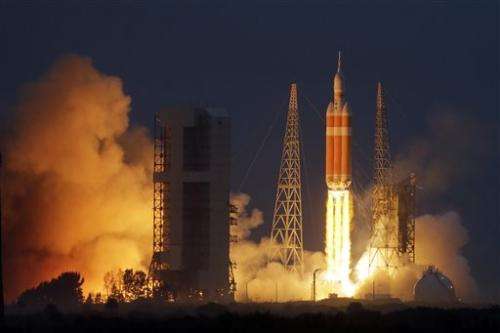
(AP)—NASA's new Orion spacecraft zoomed toward a high point of 3,600 miles (5,800 kilometers) on an orbital test flight Friday, ushering in a new era of exploration that could one day put people on Mars.
The unmanned orbital journey began with a sunrise liftoff witnessed by thousands of NASA guests. Parts of the spacecraft peeled away exactly as planned, falling back toward Earth as onboard cameras provided stunning views of our blue, cloud-covered planet.
Orion's debut will be brief—just 4½ hours from launch to splashdown, with two orbits of Earth. But for the first time in 42 years, NASA is sending a spacecraft built for humans farther than a couple hundred miles from Earth. The previous time was the Apollo 17 moon shot.
And it's NASA's first new vehicle for space travel since the shuttle.
"Very exciting," NASA's Orion program manager, Mark Geyer, said early in the flight. "We still have a bunch to go."
NASA is now "one step closer" to putting humans aboard Orion, said NASA Administrator Charles Bolden Jr. He called it "Day One of the Mars era."
Sluggish rocket valves and wind halted the launch Thursday, but everything went NASA's way Friday as the Delta IV rocket carried Orion into orbit. The first-stage boosters detached and fell away into the Atlantic as the spacecraft soared from Florida to South Africa and beyond.
NASA launch commentator Mike Curie fed the enthusiasm in the gathered crowds, calling it "the dawn of Orion in a new era of American space exploration!"
NASA was aiming for a peak altitude of 3,600 miles (5,800 kilometers) on Orion's second lap around the planet—more than 14 times higher than the International Space Station— in order to give the capsule the necessary momentum for a scorchingly high-speed re-entry over the Pacific. Engineers want to see how the heat shield—the largest of its kind ever built—to create the momentum needed to re-enter the atmosphere at 20,000 mph (32,200 kph) with an outside temperature of 4,000 degrees (2,200 Celsius). The capsule's heat shield is the largest of its kind ever made, and engineers were anxious to see how it holds up.
Back at Kennedy Space Center, the atmosphere was reminiscent of the shuttle-flying days, but considerably more upbeat than that last mission in 2011.
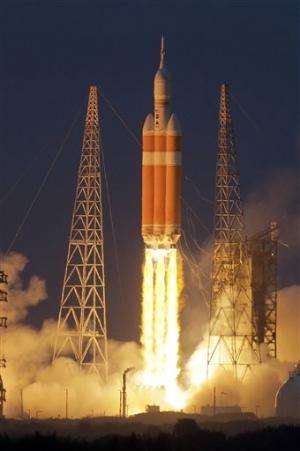
Astronaut Rex Walheim was aboard that final shuttle flight and joined dozens of space fliers on hand for this historic send-off. He talked up Orion's future in sending crews to Mars and the importance of becoming what he called "a multi-planetary species."
"You have that excitement back here at the Kennedy Space Center and it's tinged with even more excitement with what's coming down the road," Walheim said.
His enthusiasm was shared by Chris Tarkinton, who traveled from Poquoson, Virginia, to watch from the nearby causeway.
"It's been a while since we've been able to launch something of this magnitude," Tarkinton said. "Awe inspiring."
In Houston, NASA's Mission Control took over the entire operation once Orion was aloft. The flight program was loaded into Orion's computers well in advance, allowing the spacecraft to fly essentially on autopilot. Flight controllers—all shuttle veterans—could intervene in the event of an emergency breakdown.
And in the Pacific off the Mexican Baja coast, Navy ships waited for Orion's return.
The spacecraft is rigged with 1,200 sensors to gauge everything from heat to vibration to radiation. At 11 feet (3.4 meters) tall with a 16.5-foot (5-meter) base, Orion is bigger than the old-time Apollo capsules and, obviously, more advanced.
NASA deliberately kept astronauts off this first Orion.
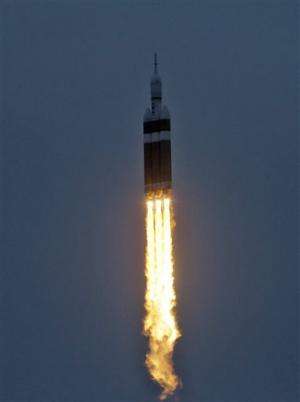
Managers want to test the riskiest parts of the spacecraft—the heat shield, parachutes, various jettisoning components—before committing to a crew. In addition, on-board computers were going to endure the high-radiation Van Allen belts; engineers wondered whether they might falter.
Friday's Orion—serial number 001—lacked seats, cockpit displays and life-support equipment for obvious reasons. Instead, bundles of toys and memorabilia were on board: bits of moon dust; the crew patch worn by Sally Ride, America's first spacewoman; a Capt. James Kirk collector's doll owned by "Star Trek" actor William Shatner, and more.
Lockheed Martin Corp. already has begun work on a second Orion, and plans to eventually build a fleet of the capsules. The earliest that astronauts might fly on an Orion is 2021. An asteroid redirected to lunar orbit is intended for the first stop in the 2020s, followed by Mars in the 2030s.
The company handled the $370 million test flight for NASA from the Cape Canaveral Air Force Station, opting for the Delta IV rocket this time given its heft. It's the most powerful unmanned rocket in the U.S. right now. The entire rocket and capsule, topped by a launch abort tower, stretched 242 feet and weighed 1.6 million pounds—an "incredible monster," according to Bolden.
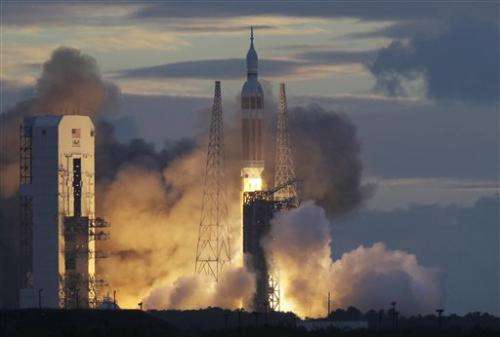
To push Orion farther out on future flights, NASA is developing a megarocket known as Space Launch System or SLS. The first Orion-SLS combo will fly around 2018, again without a crew to shake out the rocket.
NASA's last trip beyond low-Earth orbit in a vessel built for people was the three-man Apollo 17 in December 1972. Orion will be capable of carrying four astronauts on long hauls and as many as six on three-week hikes.
Bolden, a former astronaut and now NASA's No. 1, called Mars "the ultimate destination of this generation," but said his three young granddaughters think otherwise, telling him, "Don't get hung up on Mars because there are other places to go once we get there."
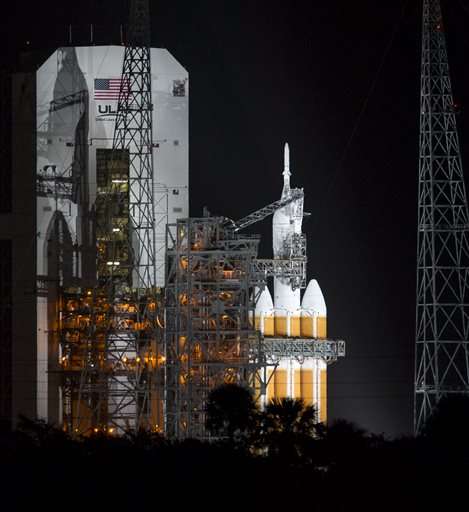
© 2014 The Associated Press. All rights reserved.





















